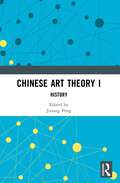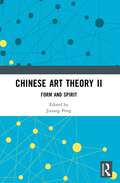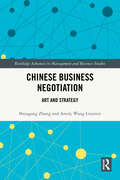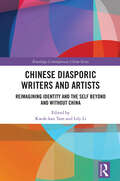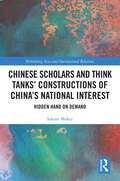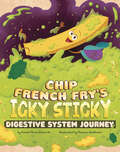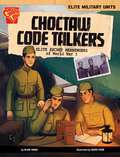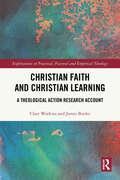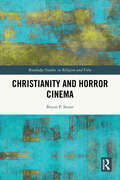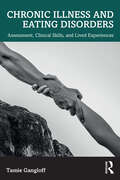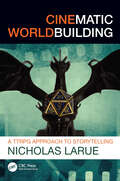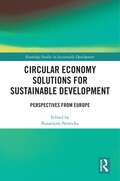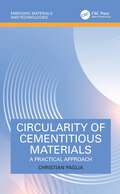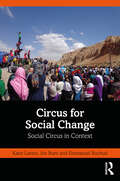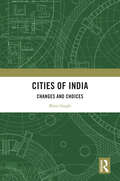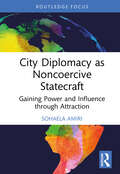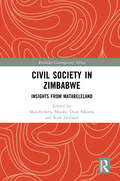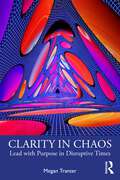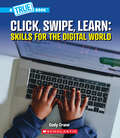- Table View
- List View
Chinese Art Theory I: History
by Jixiang PengAs the first volume of a two-volume set on traditional Chinese art, this book outlines the history of Chinese art spanning several millennia.The first volume provides a panoramic view of Chinese traditional art history by highlighting key art forms from different historical periods. It covers ancient tattoos, clothing, masks, pottery, and bronzeware, as well as the art of the Tang, Yuan, Ming, and Qing dynasties.This title is a valuable read for students and scholars of art, especially Chinese art theory and history. It will also attract those interested in the philosophical and aesthetic foundations of traditional Chinese art.
Chinese Art Theory II: Form and Spirit
by Peng JixiangAs the second volume of a two-volume set on Chinese art theory, this book introduces the typology of Chinese art and expands on the aesthetic and artistic theories of Chinese traditional art.The first part of this volume introduces representative genres of Chinese traditional art, including literary works, painting, and calligraphy. It covers scholar-artist art, folk art, palace art, and religious art at various levels and dimensions. The book demonstrates how Chinese traditional art uniquely embodies the nation's aesthetic sensibility, while reflecting its distinctive national traits in both creation and appreciation. The second part distills these theories to identify the fundamental principles and aesthetic characteristics that best represent the artistic spirit of Chinese tradition. Throughout, this book illustrates how traditional Chinese art reflects the cultural mindset and aesthetic consciousness of its people.This book is a valuable read for students and scholars of art studies, especially Chinese art theory and history. It will also appeal to anyone interested in the philosophical and aesthetic foundations of Chinese traditional art.
Chinese Business Negotiation: Art and Strategy (Routledge Advances in Management and Business Studies)
by Shougang Zhang Amily Wang GuenierChinese Business Negotiation offers readers a comprehensive insight into Chinese negotiation principles, shaped by centuries of cultural tradition and contemporary global business dynamics. Unlike competitive or zero-sum approaches, Chinese negotiation emphasizes harmony, trust, and long-term partnerships. This book introduces key concepts such as Shi (strategic advantage through interdependence), ethical wealth-seeking, and human-centered, empathy-driven communication.Structured across nine chapters, the book blends historical wisdom with modern business applications, providing practical frameworks for navigating cross-cultural negotiations. Readers will gain an understanding of strategic planning, flexible adaptation, and balanced communication in high-stakes deal-making. Case studies—including Lenovo’s acquisition of IBM’s PC division, SANY’s acquisition of Germany’s Putzmeister, Midea’s acquisition of KUKA Robotics, and Tesla’s negotiations in China—illustrate how these principles drive success in real-world scenarios.This book serves as a valuable resource for business professionals, scholars, and policymakers seeking to deepen their understanding of Chinese negotiation culture. By bridging Eastern and Western approaches, it equips readers with the tools to foster cooperative, mutually beneficial agreements in an increasingly interconnected world.
Chinese Diasporic Writers and Artists: Reimagining Identity and the Self Beyond and Without China (Routledge Contemporary China Series)
by Kwok-Kan Tam Lily LiThis book presents new and original essays that capture the enigmatic and intriguing personal and imagined worlds of Chinese writers and artists in diaspora in the twentieth and twenty-first centuries.Including chapters on artist-writers such as Gao Xingjian, Dai Sijie, Ha Jin and Hong Ying, Tyrus Wong, and Shen Wei, the book explores personal cross-cultural experiences through their literary and other artistic works, reflecting on their cultural identity, their native home, and their new home, the past and the present. By writing, filming, and painting about their diaspora/diasporic experience, they are writing about their selves and the traumatic experience many of them have gone through in forgetting the past, forgiving the damage, and foreshadowing a future by re-visioning their selves. Their experience represents a generation’s quest for an identity of being Chinese but culturally distanced from China.As a study of cross-cultural human experience through the lens of literature, film, and other arts, this book will not only appeal to students and scholars of Chinese diaspora studies, it will also appeal to those with an interest in Chinese literature, film, and culture.
Chinese Scholars and Think Tanks' Constructions of China's National Interest: Hidden Hand on Demand (Rethinking Asia and International Relations)
by Sabine MokryThis book offers a systematic assessment of how International Relations scholars in mainland China and analysts at Chinese foreign policy think tanks influence the construction of China’s national interest. The detailed analysis shows how proximity to the state and the state’s signaled demand for expertise facilitate and constrain influence and puts forward a new approach for identifying influence by applying frame analysis to 150 foreign policy statements and combining it with quantitative content analysis of 4000 expert publications. Offering a new way of assessing and explaining Chinese foreign policy experts’ influence, understanding the environment in which they operate, and providing suggestions on how to analyze official foreign policy statements, this volume will be of interest to scholars of Chinese foreign policy and anyone working on expert influence in non-democratic regimes.
Chip French Fry's Icky, Sticky Digestive System Journey
by Jamee-Marie EdwardsFollow along as Chip French Fry goes from the mouth to the stomach to the intestines and beyond. Engaging and packed with facts, this book takes readers on a step-by-step illustrated adventure to uncover the icky, sticky journey through the digestive system.
Choctaw Code Talkers
by Blake A. HoenaIn this action-packed graphic novel, readers discover the incredible story of the Choctaw Code Talkers during World War I. When the U.S. Army needed a way to communicate military plans securely, they turned to a group of Choctaw soldiers to use their native language to create unbreakable codes. Follow these brave individuals as they fight on the front lines and outsmart the enemy using their little-known language as a secret weapon. Their efforts helped change the course of World War I and paved the way for future Indigenous code talkers. With dynamic illustrations and gripping text, this nonfiction graphic novel brings history to life for young readers.
Christian Faith and Christian Learning: A Theological Action Research Account (Explorations in Practical, Pastoral and Empirical Theology)
by Clare Watkins James ButlerFollowing a critical analysis of the pedagogical theology and practice of Christian learning, this book develops a radical alternative account of ‘faith learning’. Recognising the ways in which institutionally anxious churches are turning to processes of education and ‘discipling’, it takes the reader through a theological action research journey to offer a practical–theological response to the question of how Christian faith is learnt and handed on in ways that really make a difference. Through close engagement with the practicalities of one declining denomination (British Methodism), the authors offer a distinctive vision of Christian learning and enable fresh thinking and practice. There is a call for a move beyond educational ‘courses’ towards a more profound engagement with the complexities of real life as not only the place but the ‘matter’ of faith learning. Theologically, the book offers a vision which pursues questions of divine and human agency, the work of the Spirit in ‘learning’, the role of normative tradition, and the important place of Christian lay people and their daily lives in learning. Ultimately, it seeks to give substance to a fresh concept of ‘faith learning’, which is holistic, integrative, and inductively achieved, and finds its fulfilment in lives lived in faith, hope, and love.
Christianity and Horror Cinema (Routledge Studies in Religion and Film)
by Bryan P. StoneChristianity and Horror Cinema explores ways that Christian beliefs, spiritualities, practices, and symbols provide the religious and existential "depths" out of which the monsters of Western horror cinema have emerged, arguing that they are, in several respects, the monsters for which Christians are responsible. Horror cinema preys on Christianity’s narrative, moral, cultural, and aesthetic traditions; reverses them; upends them; inverts them; and offends them. But it also reflects and relies on them. The book focuses on seven subgenres in the cinema of horror: ghosts, witches, the demonic or Satanic, vampires, nature horror, zombies, and psychological horror. Each chapter traces the history of that subgenre, taking up a theological analysis of ways that horror cinema capitalizes on ambiguities, contradictions, anxieties, and tensions in Christianity—for example, its treatment of the body, nature, sexuality, women, or those it deems pagan or religiously "other." The author examines a variety of films that are important for thinking about the relationship of Christianity to horror cinema. The book will be of interest to scholars of religion, theology, and film studies.
Christopher Columbus and the Genesis of New World Colonialism, 1493–96: An Historical Geography of his Second Voyage (Routledge Research in Historical Geography)
by Al M. RoccaThis book explores the role of geography’s five themes: location, place, human-environmental interaction, movement, and region, in Christopher Colombus’s second voyage. It explores the impacting events that led to deteriorating relations between Columbus, the Spanish settlers (adventurers), and the indigenous Taíno and Carib people, creating a social paradigm of confusion, displacement, destruction, and the genesis of New World Colonization.
Chronic Illness and Eating Disorders: Assessment, Clinical Skills, and Lived Experiences
by Tamie GangloffChronic Illness and Eating Disorders addresses the intersection of eating disorders and the importance of treatment of clients with eating disorders and chronic illness, specific interventions, and resilience in a body that continues to change.This book explores the intricacies of those with chronic illness, and how it can lead to disordered eating. Chapters cover lifelong and acquired illnesses and conditions, visible and invisible disabilities, sports injuries, chronic pain, grief, and more. The author examines how each of these conditions can affect appetite, body image, and overall perception of food and health. Treatments such as EMDR and CBT are discussed alongside mindful approaches such as body neutrality.Therapists, dietitians, and other medical professionals will gain a deep understanding of body image disturbance and how that is different than body image distortion.
Cinematic Worldbuilding: A TTRPG Approach to Storytelling
by Nicholas LaRueEverybody has a story in them. Some people lack the language and the tools to tell that story effectively. As an avid tabletop role-playing game player, I’m amazed at people’s ability to tell stories on the spot. Both the players and the game masters are creating worlds in their minds and playing out the events, using improv, in real-time. Being an author and screenwriter, I know how difficult it is to create consistent and well-constructed characters, themes, and conflicts. I believe that storytellers looking to level up in the classroom, their hobby, or career could learn a lot from games like Dungeons & Dragons, Pathfinder, and others. This book seeks to give people the tools and language to create and master their worlds and characters, using TTRPG mechanics and rulesets as foundational elements. This book will contain insights and interviews from some of today’s most respected game masters, players, actual play actors, and we’ll also hear from some of the people behind the scenes responsible for creating these games, and how they view worldbuilding and storytelling for their audiences.
Circular Economy Solutions for Sustainable Development: Perspectives from Europe (Routledge Studies in Sustainable Development)
by Katarzyna NowickaThis edited collection offers fresh perspectives on sustainable development and social impact using a circular economy framework. Against the backdrop of escalating environmental challenges such as resource depletion and climate change, transitioning from a linear to a circular economy is a key step towards meeting the UN’s Sustainable Development Goals.Circular supply chains are pivotal in this transformation, focusing on resource efficiency, recycling, and waste reduction, with consumer roles also playing a key part. Building on theoretical foundations, the chapters in this book use quantitative and qualitative research to explore practical solutions and transformative potential across industries and urban settings, addressing global economic, environmental and social challenges. This book fosters a deeper understanding of circular economy principles and inspires actionable changes, with consumers becoming active participants in the circular economy. By focusing on consumer knowledge, eco‑innovation, and urban readiness, it provides a systemic, holistic approach to circular economy studies.This book will be of interest to researchers, academics, and students interested in enhancing their understanding of circular economy principles and practices, including those in environmental science, sustainable development, economics, and business.
Circularity of Cementitious Materials: A Practical Approach (Emerging Materials and Technologies)
by Christian PagliaRecycling of materials in building and infrastructure applications are global concerns driven by natural resource preservation needs of modernized countries and sustainable development of emerging countries. This practical book explores the strategies necessary for successful recycling of cement-based materials to achieve sustainable and long service life. It investigates recycled cementitious materials to ensure decisive implementation and meet industry and societal challenges. Presents the state of the art in recycling one of the most used materials in today’s construction sector Covers construction and demolition waste and recycled concrete, UHPC, and road base material Aimed at readers in materials, civil, and construction engineering, this book offers guidance to professionals and researchers developing strategies for sustainable application of cement-based materials.
Circus for Social Change: Social Circus in Context (Routledge Advances in Theatre & Performance Studies)
by Katie Lavers Jon Burtt Emmanuel BochudIn this volume Social Circus is explored in depth by three Circus Studies scholars working with the aim of creating new ways of engaging with the field.Lavers, Burtt, and Bochud investigate the way that Social Circus transforms in response to its immediate environment, and particularly its social, political, and cultural context. Extensively illustrated, with photos of different Social Circuses around the world, and extensively annotated, Circus for Social Change: Social Circus in Context provides a portal into ways of seeing today’s Social Circus and is of interest to practitioners and scholars. Social Circuses explored in this volume include Cirqiniq in far North Canada; Galway Community Circus in the Republic of Ireland; Zip Zap Circus in Cape Town, South Africa; Circus Harmony in St. Louis, Missouri; Circus Laheto in Central Brazil; Women’s Circus in Melbourne, Australia; the Mobile Mini Children’s Circus (the MMCC) in various locations across Afghanistan; Cirque Hors Piste in Montreal, Canada; Sencirk in Dakar, Senegal; the Slow Circus Academy in Yokohama, JDS/Juggling de Shinshu, and the Moon Night Project in Nagano, Japan; Ponleu Selpak’s Performing Arts School and Phare Circus in Cambodia; Sirkus Magenta in Helsinki, Finland; and Le Plus Petit Cirque du Monde in Bagneux in the outskirts of Paris, France.This book will be of great interest to the general reader, to practitioners working within Social Circus or arts for social change, and to scholars, teachers, and students in schools, colleges, and universities.
Cities of India: Changes and Choices
by Binti SinghUrban India stands at an interesting moment in history—at the cusp of massive changes and cautious choices. This book maps the new challenges and subsequent choices that emerge as India transitions into more urbanized situations, both spatially and culturally—to cleaner and renewable energy, integrating these new norms into the built environment, providing affordable and accessible physical and social infrastructure to all citizens, addressing the disproportionate climate risks of vulnerable communities, responding to the forces of globalization, conserving our heritage assets, deploying smart technologies for better city governance, designing for all, integrating hard and soft city dimensions for better policy outcomes and greater environmental and social impacts. It underlines and explores the nuances of urban design and urban planning, as well as how they are inextricably enmeshed with sustainability and climate action.The volume will be of great interest to scholars and researchers of urban studies, sociology, South Asian Studies, built environment, sustainability and climate studies, urban design and urban planning.
City Diplomacy as Noncoercive Statecraft: Gaining Power and Influence through Attraction
by Sohaela AmiriThis book presents a rigorously designed framework for city diplomacy as a tool to enhance a nation’s international appeal, attraction, and influence. This book illustrates how attraction-based influence is generated, and why city diplomacy enhances national security and prosperity through international exchanges, collaborations, and dialogues.It provides a structured approach to guide policies, strategies, research, and analysis for city diplomacy and the broader field of international affairs.
Civil Society in Zimbabwe: Insights from Matabeleland (Routledge Contemporary Africa)
by Mandlenkosi Mpofu, Dion Nkomo and Kirk HellikerThis book considers the historical and spatial dimensions of civil society in Zimbabwe’s Matabeleland region, an area suffering from severe development and democratic deficits over many decades.Transcending an organisational conception of civil society and a simplistic state-civil society dualist understanding, it recognises the dynamic character of civil society as a social space, inclusive of less formalised associational forms of collective life, as well as the colonial character and legacies of civil society both analytically and empirically. This book facilitates a nuanced understanding of the specificities of the social, political, and economic evolution of Matabeleland in colonial and post-colonial Zimbabwe, and the region’s troubled relations with the central state. Historically, it traces civil society in Matabeleland from the region’s resistance against the colonial-settler state to contemporary struggles for justice given the unresolved Gukurahundi legacy. Civil society is depicted as constituted by a set of complex and shifting struggles for justice, not simply between Matabeleland and the central state, but also internally within Matabeleland along multiple fault lines including class and culture. The relevance of understanding civil society in Matabeleland, for Zimbabwe and Africa more widely, is brought to the fore.The book will be of interest and value to scholars of civil society, politics and democratisation across the African continent.
Clarity in Chaos: Lead with Purpose in Disruptive Times
by Megan TranterWith its fresh and deeply personal perspective on what it takes to lead with resilience and authenticity, this book challenges the traditional playbook on leadership by placing purpose at the core of every decision and action.In a world increasingly defined by uncertainty and rapid change, leadership grounded in purpose is the compass that transforms uncertainty into impact, stagnation into growth, and vision into a legacy. Drawing on her extraordinary journey from technical safety expert to global executive, Megan Tranter weaves together compelling personal anecdotes, cutting-edge research, and practical tools to show how leaders can redefine success. But this book goes beyond strategies to invite readers into an authentic dialogue about vulnerability, growth, and the kind of leadership that transforms lives – not just spreadsheets. Readers will be left feeling understood, inspired, and empowered to take courageous actions in their careers, solving the pervasive problems of burnout, disconnection, and lack of fulfillment.This book is the roadmap for seasoned executives and aspiring leaders to unlock their potential and lead with clarity and conviction.
Classical Mechanics
by Artemio González–LópezClassical Mechanics is a textbook for undergraduate students majoring in Physics (or Mathematics and Physics). The book introduces the main ideas and concepts of Newtonian, Lagrangian, and Hamiltonian mechanics, including the basics of rigid body motion and relativistic dynamics, at an intermediate to advanced level. The physical prerequisites are minimal, with a short primer included in the first chapter. As to the mathematical prerequisites, only a working knowledge of linear algebra, basic multivariate calculus, and the rudiments of ordinary differential equations is expected.Features Numerous exercises and examples A focus on mathematical rigor that will appeal to Physics students wanting to specialize in theoretical physics, or Mathematics students interested in math- ematical physics Sufficient material to service either a one- or two-semester course
Classical Mechanics: A Computational Approach with Examples Using Mathematica and Python
by Vasilis Pagonis Christopher W. KulpClassical Mechanics: A Computational Approach with Examples using Python and Mathematica provides a unique, contemporary introduction to classical mechanics, with a focus on computational methods. In addition to providing clear and thorough coverage of key topics, this textbook includes integrated instructions and treatments of computation.This newly updated and revised second edition includes two new appendices instructing the reader in both the Python and Mathematica languages. All worked example problems in the second edition contain both Python and Mathematica code. New end-of-chapter problems explore the application of computational methods to classical mechanics problems.Full of pedagogy, it contains both analytical and computational example problems within the body of each chapter. The example problems teach readers both analytical methods and how to use computer algebra systems and computer programming to solve problems in classical mechanics. End-of-chapter problems allow students to hone their skills in problem solving with and without the use of a computer. The methods presented in this book can then be used by students when solving problems in other fields both within and outside of physics.It is an ideal textbook for undergraduate students in physics, mathematics, and engineering studying classical mechanics.Key Features: Gives readers the "big picture" of classical mechanics and the importance of computation in the solution of problems in physics Numerous example problems using both analytical and computational methods, as well as explanations as to how and why specific techniques were used Online resources containing specific example codes to help students learn computational methods and write their own algorithms A solutions manual is available via the Routledge Instructor Hub and all example codes in the book are available via the Support Material tab, and at the book’s GitHub page: https://github.com/vpagonis/Classical_Mechanics_2nd_Edition
Classical Rhetorical Argumentation for the Rhetorical Critic (Routledge Studies in Rhetoric and Communication)
by Mika HietanenThis book offers a reassessment of argumentation in classical rhetoric, foregrounding its rational dimension. Moving beyond introductions, it provides insights from Aristotle, Quintilian, and other ancient thinkers while addressing common misconceptions and offering clarifications that are particularly valuable for the rhetorical critic.Adopting a Scandinavian rhetorical perspective, this book argues that classical rhetoric offers enduring tools for both the analysis and the construction of persuasive argumentation. By bridging theory and practice, it demonstrates how classical rhetoric remains highly relevant, while also naturally integrating with analyses that focus on classical concepts such as ethos, pathos, or style – whether through neo‑Aristotelian methods or contemporary approaches rooted in the classical rhetorical tradition. Key concepts are explored in dedicated chapters: the ‘art’ of logos‑based argumentation is reassessed; enthymeme and epicheireme structures are examined; and topoi and staseis are discussed in relation to their later developments. A chapter on the centenary of rhetorical criticism traces its evolution from Herbert Wichelns (1925) to today, proposing a new template for the rhetorical critic.This concise yet comprehensive book will interest intermediate and advanced students, as well as scholars of rhetoric, argumentation, persuasion, speech and writing studies, and communication studies.
Click, Swipe, Learn: Skills for the Digital World (A True Book)
by Cody CraneHow can kids use the internet smartly? Discover it with this step-by-step guide for young readers.Kids spend about five hours a day connecting with digital content-consuming it and/or creating it. Some of that content might include misinformation and altered images. It may even promote biases or dangerous ideas. Creating content includes pitfalls too-from copyright infringement to posting information that could be harmful or damaging. That's why digital literacy is so important. Click, Swipe, Learn: Skills for the Digital World uses engaging, interactive text-including critical-thinking questions-to show kids exactly what they need to watch out for as they navigate the digital world.ABOUT THIS SERIES:The world of media and technology is changing fast-and young students are right there in the thick of it. As children try to make sense of new technologies, they face a variety of critical issues, including how to access reliable sources of information, how to protect themselves online, and how to use technology in mindful and respectful ways. That's where the books in the Our Digital Future series can help. Each title has been developed to help young readers think critically and navigate new technologies with confidence and care.
Client Education: Theory and Practice
by Mary A. Miller Pamella Rae StoeckelClient Education: Theory and Practice, Fourth Edition teaches nursing students the important skills of patient education and health promotion. The authors use their unique Miller-Stoeckel Client Education Model as the organizing framework to emphasize the importance of the Nurse-Client Relationship and how this relationship is paramount to the success of client education. They focus on the key role that nurses play in educating individuals, families and groups in clinical settings. The updated Fourth Edition addresses the need for health education in nursing by covering the learning process and discussing the needs of clients across the age span. The authors’ thoughtful revision includes updated statistics on chronic diseases and new data on generations Z and Alpha. Furthermore, they teach students how to work with culturally diverse populations by presenting specific teaching approaches.
Climate Action and Civil Society in Turkey and Germany: Contested Common Ground (Routledge Advances in Climate Change Research)
by Hande PakerThis book explores the social and political dynamics that shape the impacts of climate change, drawing upon Turkey and Germany to offer a comprehensive comparative analysis.Civil society representatives, the climate movement, the youth, and arts and culture actors from around the world unequivocally call for a deep transformation of political, economic, and social structures in order to avoid the devastating effects of climate change. The transformation that is prescribed is perceived as insufficient, technocratic, and market-based and does not involve challenging power relations at the heart of climate action. This book addresses these concerns, using a comparative analysis to explore the issues and efficiency of a meaningful sustainable transition. The in-depth comparison of two conventionally dissimilar cases, Turkey and Germany, demonstrates that civil society actors in different political settings can use similar strategies and frames for climate action against state actors. In turn, states use similar depoliticization strategies (albeit via different mechanisms) and economic growth narratives to reproduce hegemony. The book untangles the different processes that create the contentious, politicized common ground in which these stakeholders interact with each other. The findings of this research have significant implications for many developing and developed countries alike where climate policymaking is painstakingly inadequate.This book will be of interest to students, researchers, and academics interested in political ecology, climate politics, and politics of development.
